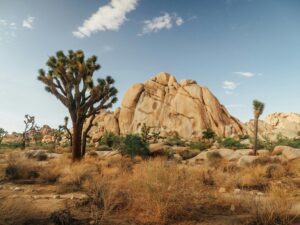
A recent report by the National Parks Conservation Association (NPCA) using data collected in 2021 identifies four California National parks with the most unhealthy air: Sequoia and Kings Canyon, Joshua Tree, Mojave and Yosemite. This was cause for concern, given the increasingly noticeable destruction due to the effects of climate change. The harm being done to California’s national parks is incredibly concerning, and California needs to prioritize addressing the effects and causes of climate change.
The nearby Joshua Tree National Park was ranked as the second most ozone-polluted park. The park is still recovering from the 43,273-acre wildfire in August 2020, which burned approximately 1.3 million Joshua trees. The survival of this ecosystem has already been threatened by urban expansion and the presence of invasive plants. The presence of these non-native plants has decreased the availability of water and, therefore, has increased the probability of wildfire. Climate change has worsened the effects as the park has become hotter and drier due to growing greenhouse gas emissions. Yearly precipitation has decreased by 39% from 1895 to 2016, killing vegetation and increasing fuel supply for wildfires. This new reality makes it hard to see cuts to water reuse and groundwater management remediation, among other things, as anything other than an act of nonsense. Diverting funding from water resilience is plain ignorance.
California has been a battleground, with the destruction largely centered around wildfires. Fueled by the changing climate, these wildfires have been the primary culprits behind the devastation we see today. In 2023, California dedicated $113 million of the California Climate commitment budget to 96 wildfire prevention projects. In a statement, Newsom stated, “Our goal is to stop devastation before it happens – to keep Californians safe, and preserve our communities and shared history.” California has options in the realm of wildfire prevention, and the National Parks Service does employ tactics to prevent wildfires, including purposely burning areas that are at risk. It’s disheartening that California has a way to handle natural disasters with more grace and capability than it can hold Big Oil and major polluters accountable.
The changes in precipitation and temperature endanger national parks’ natural flora and fauna, which stand as the last defense between nature and an entirely industrialized world. Nature in its purest form is dying out of existence, and with worrisome figures coming out of California, it should be the goal of lawmakers to support environmental protection. However, as California faces a substantial budget deficit, climate programs were early onto the chopping block.
In total, Gov. Gavin Newsom’s budget proposal cut approximately $2.9 billion from California climate programs and delayed another $1.9 billion. While California’s current spending on climate change exceeds those of many nations, it’s clear that California wasn’t able to address the issue with the money it had before the cuts. While throwing more money into the problem might not be the perfect solution, taking money away and gutting climate programs is almost certainly going to do damage. A decent chunk of funding has been taken from programs that accurately address climate stressors. The NPCA report did find promising data suggesting that several measures of air quality improved significantly, and this kind of improvement is not something California’s population and parks can afford to back off of.
Overall, future Californians deserve to experience the value of nature and environmental preservation rather than become victims of shifting baseline syndrome. Joshua Tree, in particular, is uniquely biodiverse and stands as a testament to the importance of nature in nearby counties that are inundated with warehouses. Furthermore, this is not something that can just be regrown. Currently, there is a question of whether or not the area decimated in Joshua Tree by the Dome fire will ever fully recover and what it will do to the park overall. Nature isn’t preserved solely for its own sake; these parks are a part of American history, and they do not belong to America in the first place.
California State Parks might be able to act to address climate change in some capacity by hiring permanent staff that works to address these challenges and stressors and spending a significant amount of the budget to prevent the increasing presence of wildfires and rising sea-levels. The executive director of the California State Parks Foundation made a statement saying, “And if [the state] chooses to not invest, and not see these places as essential and critical to the success of our climate goals, then we might fail,” she said. “And that’s kind of unthinkable.” These parks, state and national, are essential to the defense of what is left of the environment.
California needs to go beyond the extra mile to continue greenhouse gas reductions and improve air quality as the state faces floods and heat waves in addition to the prevalent wildfires. If things continue as they are, California will no longer have a fire season, the state will just be on fire.








